Attached files
| file | filename |
|---|---|
| 8-K - FORM 8-K - ACI WORLDWIDE, INC. | c63370e8vk.htm |
Exhibit 99.1

| March 2011 ACI Worldwide Investor Conferences 1 ACI’s software underpins electronic payments throughout retail and wholesale banking, and commerce all the time. |
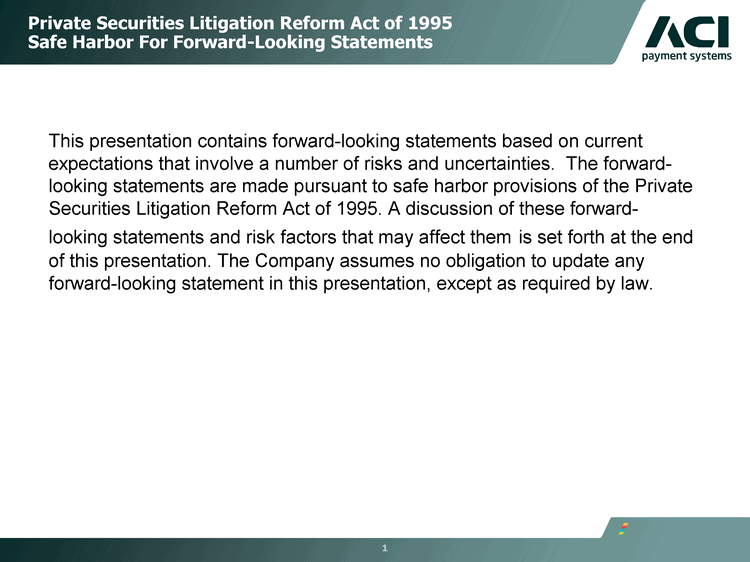
| This presentation contains forward-looking statements based on current expectations that involve a number of risks and uncertainties. The forward- looking statements are made pursuant to safe harbor provisions of the Private Securities Litigation Reform Act of 1995. A discussion of these forward- looking statements and risk factors that may affect them is set forth at the end of this presentation. The Company assumes no obligation to update any forward-looking statement in this presentation, except as required by law. Private Securities Litigation Reform Act of 1995 Safe Harbor For Forward-Looking Statements |

| Business Overview Phil Heasley Chief Executive Officer |
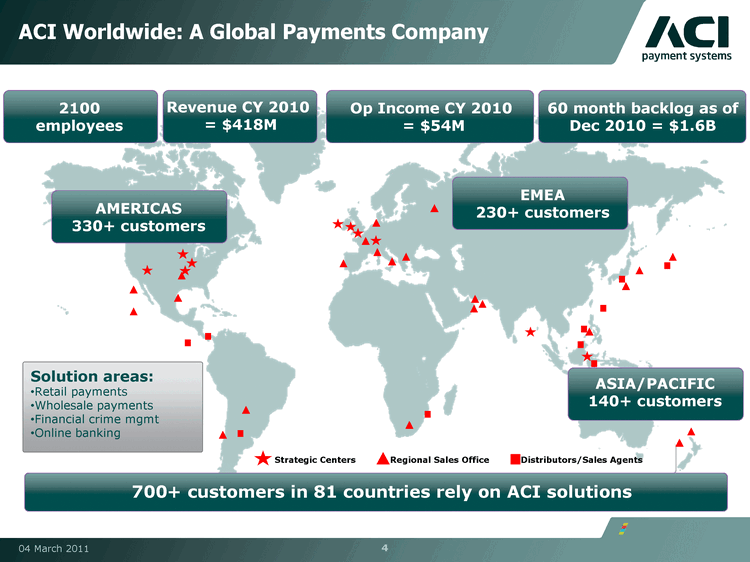
| ACI Worldwide: A Global Payments Company 04 March 2011 4 Strategic Centers Regional Sales Office Distributors/Sales Agents Solution areas: Retail payments Wholesale payments Financial crime mgmt Online banking 2100 employees Revenue CY 2010 = $418M Op Income CY 2010 = $54M 60 month backlog as of Dec 2010 = $1.6B AMERICAS 330+ customers EMEA 230+ customers ASIA/PACIFIC 140+ customers 700+ customers in 81 countries rely on ACI solutions |

| ACI's software underpins electronic payments throughout retail and wholesale banking Retail Payments: Electronic Payment Processing Software supporting ATM's and POS terminals, switching, and various authentications, authorization and reporting options for internet banking, branch and mobile systems Wholesale Payments: Wholesale payments solutions provide treasury management services to large corporations Online Banking: Online business banking product for financial institutions including banks, brokerage firms and credit unions and can be flexibly packaged for small, medium and large business customers Fraud Detection & Prevention: Prevention, detection and resolution of financial crime in payments Back Office: Card issuer, merchant acquirer end-to-end solutions, including settlement and reconciliation |

| ACI Market Share 04 March 2011 6 BANKING 22 of the top 25 in the U.S. 4 of the top 5 in Brazil 5 of the top 10 in Malaysia 8 of the top 10 in Canada 7 of the top 10 in Saudi Arabia 8 of the top 10 in India MERCHANT RETAIL PROCESSORS 6 of the top 6 in Australia 7 of the top 10 in the U.K. 4 of the top 10 in Mexico 6 of the top 10 in China 6 of the top 10 in Indonesia 4 of the top 5 in South Africa 3 of the top 5 in Greece 3 of the top 5 in Netherlands 6 of the top 25 global retailers Over 140 processors globally 42 customers in the top 100 world banks 8 of the top 10 in Thailand |
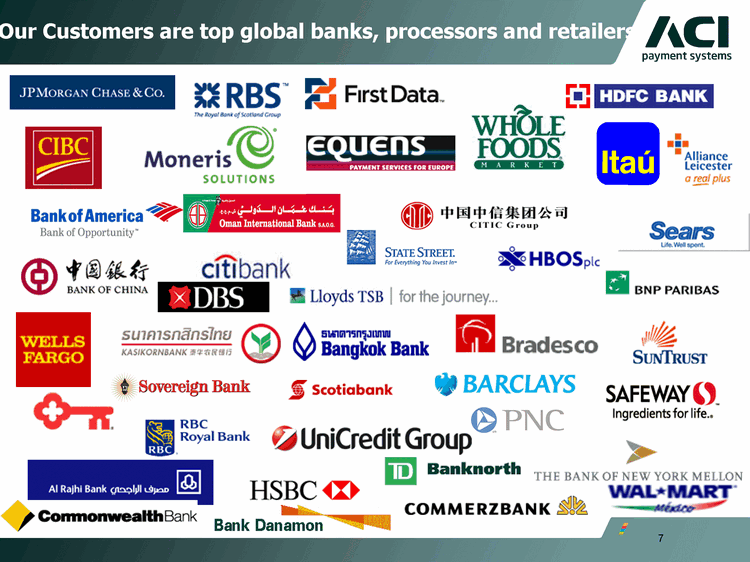
| 7 Our Customers are top global banks, processors and retailers |

| Building Long Term Shareholder Value In 5th year of cycle to renew previously discounted term licenses at economic value Increased 60-month backlog by $300 million since 2007 Drove monthly recurring revenue to 68% of the business, up 10% from 58% of the business in 2007 Grew operating margin by 1300 basis points since 2007 Growth of business through selling new customers and new applications to existing customers Established Global Account business Increased operating free cash flow generation |

| 2011 Market Opportunities Cross selling new applications to current customers based on integrated payments solutions portfolio Investing in resources to accelerate our growth in emerging markets (Brazil, China, etc) Multi-region wholesale market payment hubs Driving BASE24-eps(r) migrations Tools solutions in demand for monitoring, transaction testing and ensuring availability New ACI IssuerTM /ACI AcquirerTM/ ACI InterchangeTM sales to banks, processors, ISOs Global Account deals Continuing renewal of long-term customer relationships |

| Scott Behrens Chief Financial Officer Financial Review |
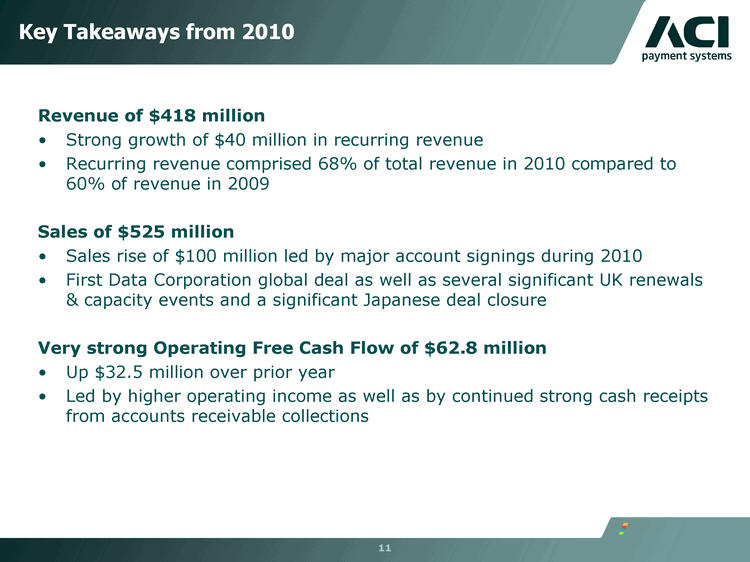
| Key Takeaways from 2010 Revenue of $418 million Strong growth of $40 million in recurring revenue Recurring revenue comprised 68% of total revenue in 2010 compared to 60% of revenue in 2009 Sales of $525 million Sales rise of $100 million led by major account signings during 2010 First Data Corporation global deal as well as several significant UK renewals & capacity events and a significant Japanese deal closure Very strong Operating Free Cash Flow of $62.8 million Up $32.5 million over prior year Led by higher operating income as well as by continued strong cash receipts from accounts receivable collections |

| Key Takeaways from 2010 60-Month Backlog growth of $54 million to $1.6 billion over prior year Strong Growth in Operating Income Up $12.0 million, or 29%, over prior-year quarter Strong Growth in Operating EBITDA Up $14.9 million, or 20%, over prior-year quarter |
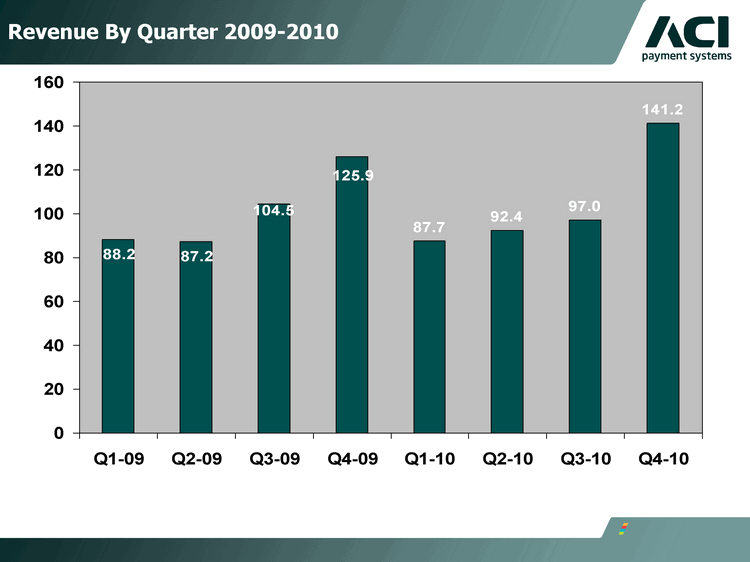
| Q1-09 Q2-09 Q3-09 Q4-09 Q1-10 Q2-10 Q3-10 Q4-10 88.2 87.2 104.5 125.9 87.7 92.4 97 141.2 Revenue By Quarter 2009-2010 |

| Operating Income by Quarter 2009-2010 Q1-09 Q2-09 Q3-09 Q4-09 Q1-10 Q2-10 Q3-10 Q4-10 Operating Income -2.1 -3.2 11.9 35 -0.9 4.4 7.4 42.8 |
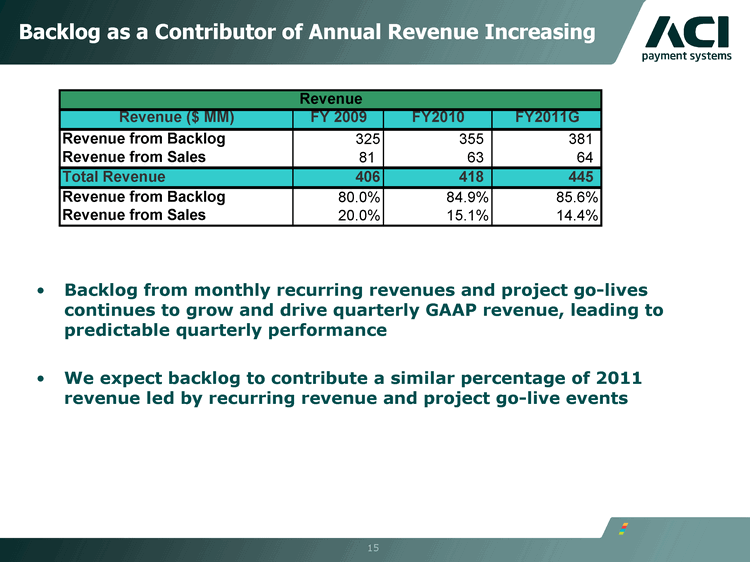
| Backlog as a Contributor of Annual Revenue Increasing Backlog from monthly recurring revenues and project go-lives continues to grow and drive quarterly GAAP revenue, leading to predictable quarterly performance We expect backlog to contribute a similar percentage of 2011 revenue led by recurring revenue and project go-live events 15 |
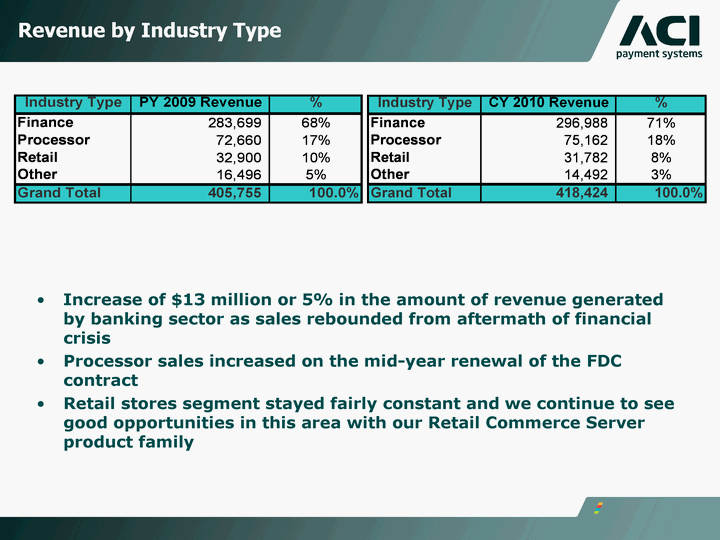
| Revenue by Industry Type Increase of $13 million or 5% in the amount of revenue generated by banking sector as sales rebounded from aftermath of financial crisis Processor sales increased on the mid-year renewal of the FDC contract Retail stores segment stayed fairly constant and we continue to see good opportunities in this area with our Retail Commerce Server product family product family product family product family product family product family product family product family product family |
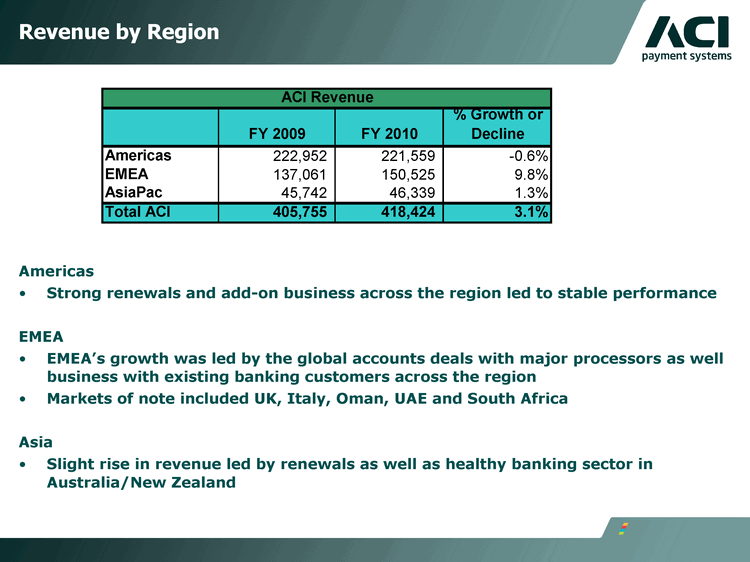
| Revenue by Region Americas Strong renewals and add-on business across the region led to stable performance EMEA EMEA's growth was led by the global accounts deals with major processors as well business with existing banking customers across the region Markets of note included UK, Italy, Oman, UAE and South Africa Asia Slight rise in revenue led by renewals as well as healthy banking sector in Australia/New Zealand |
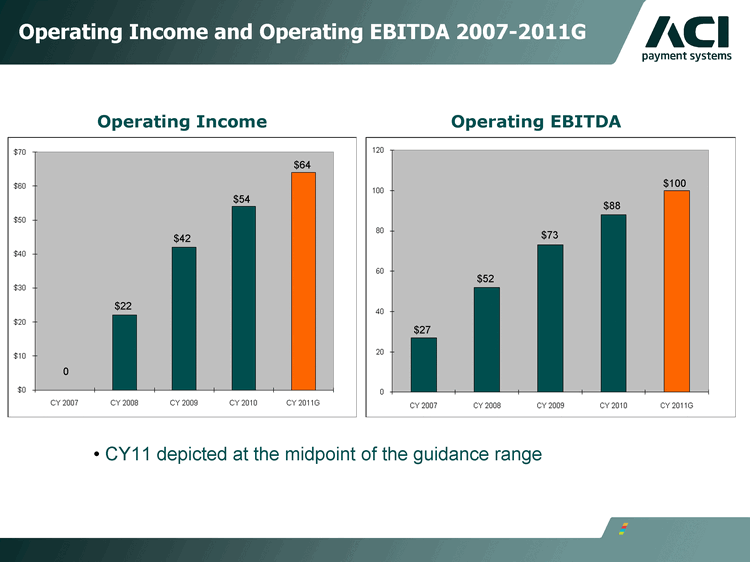
| Operating Income and Operating EBITDA 2007-2011G Operating Income Operating EBITDA 0 $22 $42 $54 $64 $27 $52 $73 $88 $100 CY11 depicted at the midpoint of the guidance range |
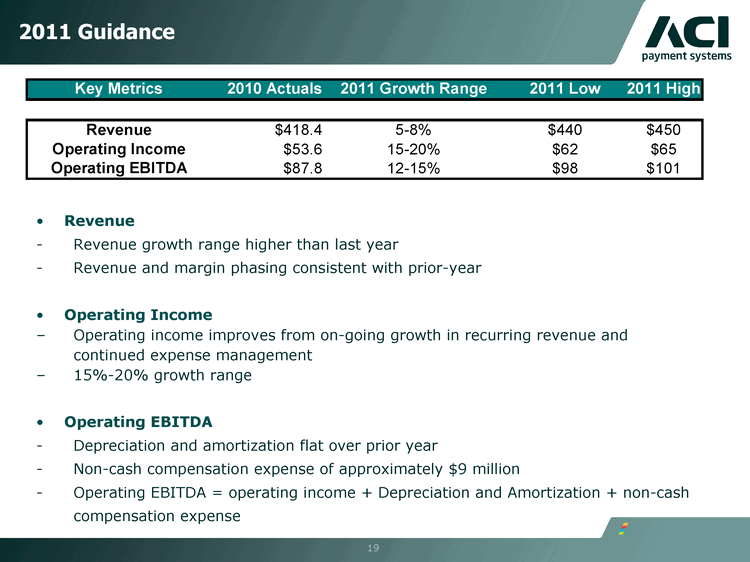
| 2011 Guidance 19 Revenue Revenue growth range higher than last year Revenue and margin phasing consistent with prior-year Operating Income Operating income improves from on-going growth in recurring revenue and continued expense management 15%-20% growth range Operating EBITDA Depreciation and amortization flat over prior year Non-cash compensation expense of approximately $9 million Operating EBITDA = operating income + Depreciation and Amortization + non-cash compensation expense |

| Non-GAAP Financial Measures ACI is presenting operating free cash flow, which is defined as net cash provided (used) by operating activities, less net after-tax payments associated with employee related activities, net after-tax payments associated with IBM IT outsourcing transition and severance, and capital expenditures and plus or minus net proceeds from IBM. Operating free cash flow is considered a non-GAAP financial measure as defined by SEC Regulation G. We utilize this non-GAAP financial measure, and believe it is useful to investors, as an indicator of cash flow available for debt repayment and other investing activities, such as capital investments and acquisitions. We utilize operating free cash flow as a further indicator of operating performance and for planning investing activities. Operating free cash flow should be considered in addition to, rather than as a substitute for, net cash provided (used) by operating activities. A limitation of operating free cash flow is that it does not represent the total increase or decrease in the cash balance for the period. This measure also does not exclude mandatory debt service obligations and, therefore, does not represent the residual cash flow available for discretionary expenditures. We believe that operating free cash flow is useful to investors to provide disclosures of our operating results on the same basis as that used by our management. We also believe that this measure can assist investors in comparing our performance to that of other companies on a consistent basis without regard to certain items, which do not directly affect our ongoing cash flow. 20 |
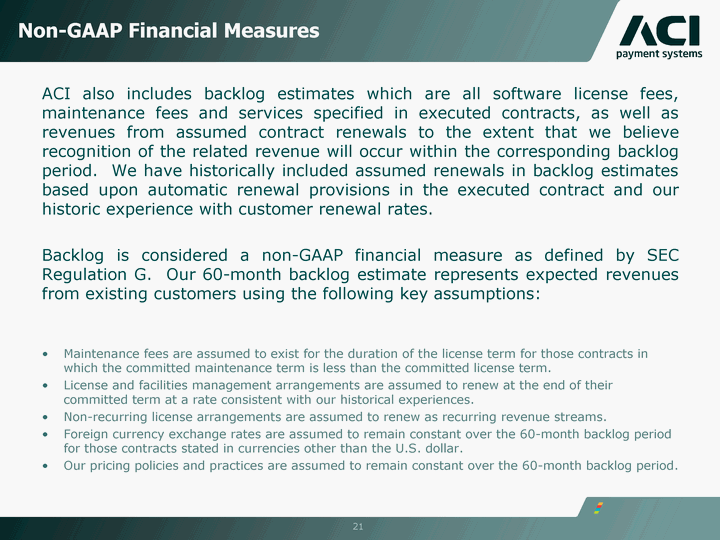
| Non-GAAP Financial Measures ACI also includes backlog estimates which are all software license fees, maintenance fees and services specified in executed contracts, as well as revenues from assumed contract renewals to the extent that we believe recognition of the related revenue will occur within the corresponding backlog period. We have historically included assumed renewals in backlog estimates based upon automatic renewal provisions in the executed contract and our historic experience with customer renewal rates. Backlog is considered a non-GAAP financial measure as defined by SEC Regulation G. Our 60-month backlog estimate represents expected revenues from existing customers using the following key assumptions: Maintenance fees are assumed to exist for the duration of the license term for those contracts in which the committed maintenance term is less than the committed license term. License and facilities management arrangements are assumed to renew at the end of their committed term at a rate consistent with our historical experiences. Non-recurring license arrangements are assumed to renew as recurring revenue streams. Foreign currency exchange rates are assumed to remain constant over the 60-month backlog period for those contracts stated in currencies other than the U.S. dollar. Our pricing policies and practices are assumed to remain constant over the 60-month backlog period. 21 |

| Non-GAAP Financial Measures Estimates of future financial results are inherently unreliable. Our backlog estimates require substantial judgment and are based on a number of assumptions as described above. These assumptions may turn out to be inaccurate or wrong, including for reasons outside of management's control. For example, our customers may attempt to renegotiate or terminate their contracts for a number of reasons, including mergers, changes in their financial condition, or general changes in economic conditions in the customer's industry or geographic location, or we may experience delays in the development or delivery of products or services specified in customer contracts which may cause the actual renewal rates and amounts to differ from historical experiences. Changes in foreign currency exchange rates may also impact the amount of revenue actually recognized in future periods. Accordingly, there can be no assurance that contracts included in backlog estimates will actually generate the specified revenues or that the actual revenues will be generated within the corresponding 60-month period. Backlog should be considered in addition to, rather than as a substitute for, reported revenue and deferred revenue. ACI also includes Operating EBITDA, which is defined as operating income (loss) plus depreciation and amortization and non-cash compensation. Operating EBITDA is considered a non-GAAP financial measure as defined by SEC Regulation G. Operating EBITDA should be considered in addition to, rather than as a substitute for, operating income (loss). 22 |
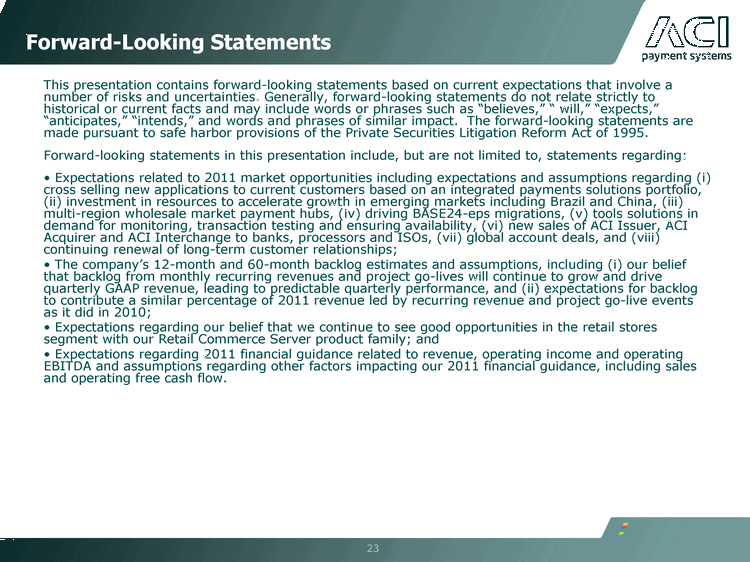
| Forward-Looking Statements This presentation contains forward-looking statements based on current expectations that involve a number of risks and uncertainties. Generally, forward-looking statements do not relate strictly to historical or current facts and may include words or phrases such as "believes," " will," "expects," "anticipates," "intends," and words and phrases of similar impact. The forward-looking statements are made pursuant to safe harbor provisions of the Private Securities Litigation Reform Act of 1995. Forward-looking statements in this presentation include, but are not limited to, statements regarding: • Expectations related to 2011 market opportunities including expectations and assumptions regarding (i) cross selling new applications to current customers based on an integrated payments solutions portfolio, (ii) investment in resources to accelerate growth in emerging markets including Brazil and China, (iii) multi-region wholesale market payment hubs, (iv) driving BASE24-eps migrations, (v) tools solutions in demand for monitoring, transaction testing and ensuring availability, (vi) new sales of ACI Issuer, ACI Acquirer and ACI Interchange to banks, processors and ISOs, (vii) global account deals, and (viii) continuing renewal of long-term customer relationships; The company's 12-month and 60-month backlog estimates and assumptions, including (i) our belief that backlog from monthly recurring revenues and project go-lives will continue to grow and drive quarterly GAAP revenue, leading to predictable quarterly performance, and (ii) expectations for backlog to contribute a similar percentage of 2011 revenue led by recurring revenue and project go-live events as it did in 2010; Expectations regarding our belief that we continue to see good opportunities in the retail stores segment with our Retail Commerce Server product family; and Expectations regarding 2011 financial guidance related to revenue, operating income and operating EBITDA and assumptions regarding other factors impacting our 2011 financial guidance, including sales and operating free cash flow. 20 |
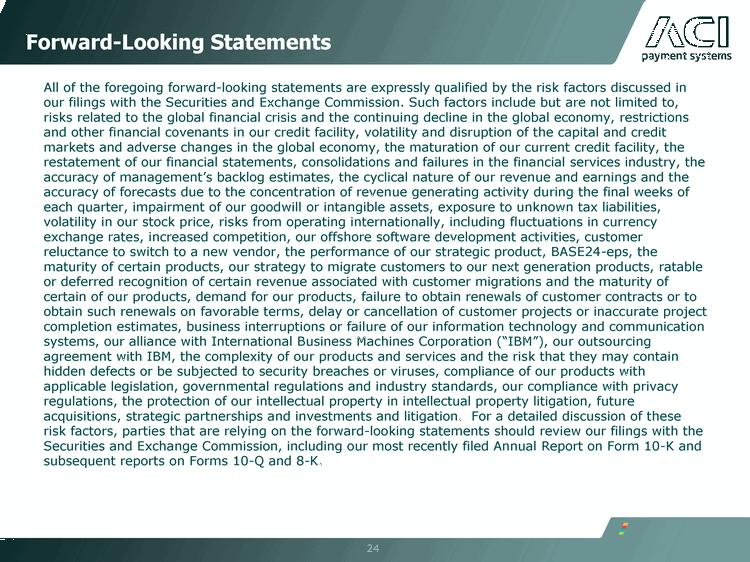
| Forward-Looking Statements All of the foregoing forward-looking statements are expressly qualified by the risk factors discussed in our filings with the Securities and Exchange Commission. Such factors include but are not limited to, risks related to the global financial crisis and the continuing decline in the global economy, restrictions and other financial covenants in our credit facility, volatility and disruption of the capital and credit markets and adverse changes in the global economy, the maturation of our current credit facility, the restatement of our financial statements, consolidations and failures in the financial services industry, the accuracy of management's backlog estimates, the cyclical nature of our revenue and earnings and the accuracy of forecasts due to the concentration of revenue generating activity during the final weeks of each quarter, impairment of our goodwill or intangible assets, exposure to unknown tax liabilities, volatility in our stock price, risks from operating internationally, including fluctuations in currency exchange rates, increased competition, our offshore software development activities, customer reluctance to switch to a new vendor, the performance of our strategic product, BASE24-eps, the maturity of certain products, our strategy to migrate customers to our next generation products, ratable or deferred recognition of certain revenue associated with customer migrations and the maturity of certain of our products, demand for our products, failure to obtain renewals of customer contracts or to obtain such renewals on favorable terms, delay or cancellation of customer projects or inaccurate project completion estimates, business interruptions or failure of our information technology and communication systems, our alliance with International Business Machines Corporation ("IBM"), our outsourcing agreement with IBM, the complexity of our products and services and the risk that they may contain hidden defects or be subjected to security breaches or viruses, compliance of our products with applicable legislation, governmental regulations and industry standards, our compliance with privacy regulations, the protection of our intellectual property in intellectual property litigation, future acquisitions, strategic partnerships and investments and litigation. For a detailed discussion of these risk factors, parties that are relying on the forward-looking statements should review our filings with the Securities and Exchange Commission, including our most recently filed Annual Report on Form 10-K and subsequent reports on Forms 10-Q and 8-K. 21 |

| ACI's software underpins electronic payments throughout retail and wholesale banking, and commerce all the time, without fail. www.aciworldwide.com |
